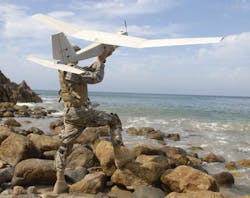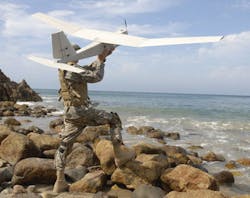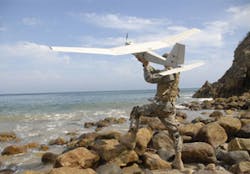AeroVironment Puma AE: first hand-launched small unmanned aircraft system approved for commercial missions
MONROVIA, Calif., 29 July 2013.AeroVironment Inc. (NASDAQ:AVAV) received a “Restricted Category” rating for its Puma AE small unmanned aircraft system (sUAS) from the Federal Aviation Administration (FAA).
“The first-of-its-kind certificate permits operators to fly Puma for commercial missions,” such as oil spill monitoring and ocean surveys, in the North Slope region of the Arctic, a spokesperson reveals. FAA admit that previous military acceptance of the Puma AE design allowed the FAA to issue the Restricted Category type certificate.
Prior to the FAA issuing this Restricted Category type certificate, it was not possible to operate an unmanned aircraft system (UAS) in the national airspace for commercial operations. A potential user could obtain an experimental airworthiness certificate, but it specifically excluded and did not authorize the use of an UAS for commercial operations.
“This certificate represents an aviation milestone that could not have happened without the FAA’s vision and leadership,” says Tim Conver, AeroVironment chairman and chief executive officer. “Aerial observation missions can now be safely accomplished in hazardous Arctic locations, which will reduce the risk of manned aviation in an efficient, cost-effective, and environmentally friendly manner. We believe initial operations in the Arctic can lead to long-term broad adoption for similar applications elsewhere in the United States and throughout the world.”Researchers and other entities now will be able to perform aerial observation at lower operational costs compared to manned aircraft. Puma AeroVironment officials expect Puma AE to be deployed later this summer to support emergency response crews for oil spill monitoring and wildlife observation off the coast of the Beaufort Sea in the Arctic Circle.
“Because Puma is a very quiet aircraft and battery operated it can monitor critical natural wildlife habitats at low altitudes without disturbing the animals or adversely affecting pristine environments,” says Roy Minson, AeroVironment senior vice president and general manager of the company’s Unmanned Aircraft Systems business segment. “Puma also is very flexible and easy to use because operators can take it anywhere without needing to haul any infrastructure, such as a launcher or recovery device, on the missions. This is especially important for oceangoing vessels, since installing new infrastructure can be a long and costly process.”
AE also gives personnel the ability to immediately obtain and analyze aerial monitoring data because they will be able to hand launch Puma AE whenever needed, giving them a new option to traditional methods, such as manned aircraft, support ships, and satellites.
The 13-pound Puma AE does not require any infrastructure, such as runways, launching pads, or recovery devices. It is man-portable and can be assembled in minutes, hand-launched, and recovered on sea or land.
Follow Avionics Intelligence news updates on Twitter (@Avionics_Intel), LinkedIn, and Google+.


